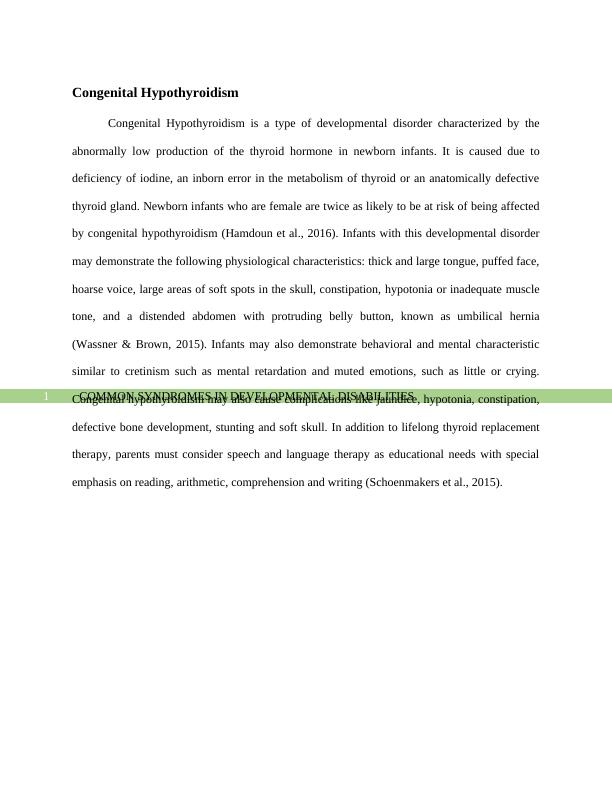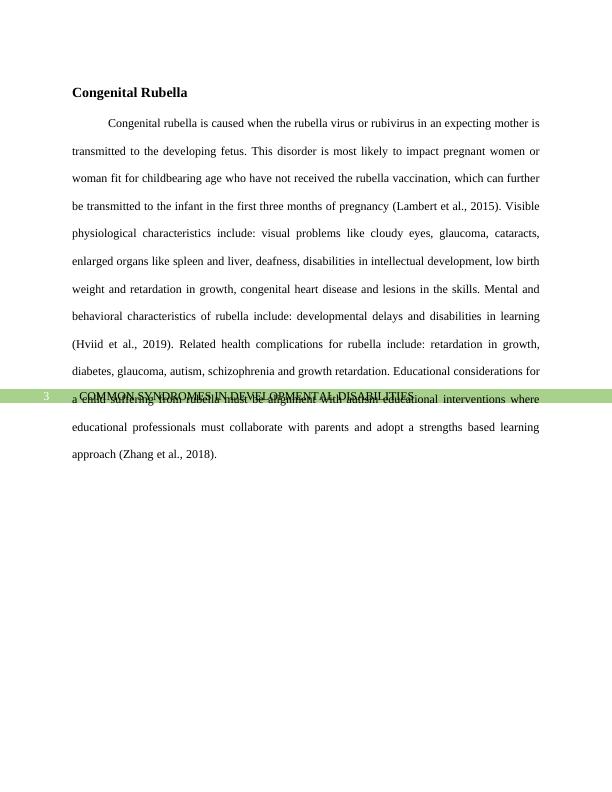COMMON SYNDROMES IN DEVELOPMENTAL DISABILITIES
12 Pages1718 Words17 Views
Added on 2022-09-09
COMMON SYNDROMES IN DEVELOPMENTAL DISABILITIES
Added on 2022-09-09
ShareRelated Documents
Running head: COMMON SYNDROMES IN DEVELOPMENTAL DISABILITIES
COMMON SYNDROMES IN DEVELOPMENTAL DISABILITIES
Name of the Student:
Name of the University:
Author note:
COMMON SYNDROMES IN DEVELOPMENTAL DISABILITIES
Name of the Student:
Name of the University:
Author note:

COMMON SYNDROMES IN DEVELOPMENTAL DISABILITIES1
Congenital Hypothyroidism
Congenital Hypothyroidism is a type of developmental disorder characterized by the
abnormally low production of the thyroid hormone in newborn infants. It is caused due to
deficiency of iodine, an inborn error in the metabolism of thyroid or an anatomically defective
thyroid gland. Newborn infants who are female are twice as likely to be at risk of being affected
by congenital hypothyroidism (Hamdoun et al., 2016). Infants with this developmental disorder
may demonstrate the following physiological characteristics: thick and large tongue, puffed face,
hoarse voice, large areas of soft spots in the skull, constipation, hypotonia or inadequate muscle
tone, and a distended abdomen with protruding belly button, known as umbilical hernia
(Wassner & Brown, 2015). Infants may also demonstrate behavioral and mental characteristic
similar to cretinism such as mental retardation and muted emotions, such as little or crying.
Congenital hypothyroidism may also cause complications like jaundice, hypotonia, constipation,
defective bone development, stunting and soft skull. In addition to lifelong thyroid replacement
therapy, parents must consider speech and language therapy as educational needs with special
emphasis on reading, arithmetic, comprehension and writing (Schoenmakers et al., 2015).
Congenital Hypothyroidism
Congenital Hypothyroidism is a type of developmental disorder characterized by the
abnormally low production of the thyroid hormone in newborn infants. It is caused due to
deficiency of iodine, an inborn error in the metabolism of thyroid or an anatomically defective
thyroid gland. Newborn infants who are female are twice as likely to be at risk of being affected
by congenital hypothyroidism (Hamdoun et al., 2016). Infants with this developmental disorder
may demonstrate the following physiological characteristics: thick and large tongue, puffed face,
hoarse voice, large areas of soft spots in the skull, constipation, hypotonia or inadequate muscle
tone, and a distended abdomen with protruding belly button, known as umbilical hernia
(Wassner & Brown, 2015). Infants may also demonstrate behavioral and mental characteristic
similar to cretinism such as mental retardation and muted emotions, such as little or crying.
Congenital hypothyroidism may also cause complications like jaundice, hypotonia, constipation,
defective bone development, stunting and soft skull. In addition to lifelong thyroid replacement
therapy, parents must consider speech and language therapy as educational needs with special
emphasis on reading, arithmetic, comprehension and writing (Schoenmakers et al., 2015).

COMMON SYNDROMES IN DEVELOPMENTAL DISABILITIES2
References
Hamdoun, E., Karachunski, P., Nathan, B., Fischer, M., Torkelson, J. L., Drilling, A., & Petryk,
A. (2016). Case Report: The Specter of Untreated Congenital Hypothyroidism in
Immigrant Families. Pediatrics, 137(5), e20153418.
Schoenmakers, N., Alatzoglou, K. S., Chatterjee, V. K., & Dattani, M. T. (2015). Recent
advances in central congenital hypothyroidism. Journal of Endocrinology, 227(3), R51-
R71.
Wassner, A. J., & Brown, R. S. (2015). Congenital hypothyroidism: recent advances. Current
Opinion in Endocrinology & Diabetes and Obesity, 22(5), 407-412.
References
Hamdoun, E., Karachunski, P., Nathan, B., Fischer, M., Torkelson, J. L., Drilling, A., & Petryk,
A. (2016). Case Report: The Specter of Untreated Congenital Hypothyroidism in
Immigrant Families. Pediatrics, 137(5), e20153418.
Schoenmakers, N., Alatzoglou, K. S., Chatterjee, V. K., & Dattani, M. T. (2015). Recent
advances in central congenital hypothyroidism. Journal of Endocrinology, 227(3), R51-
R71.
Wassner, A. J., & Brown, R. S. (2015). Congenital hypothyroidism: recent advances. Current
Opinion in Endocrinology & Diabetes and Obesity, 22(5), 407-412.

COMMON SYNDROMES IN DEVELOPMENTAL DISABILITIES3
Congenital Rubella
Congenital rubella is caused when the rubella virus or rubivirus in an expecting mother is
transmitted to the developing fetus. This disorder is most likely to impact pregnant women or
woman fit for childbearing age who have not received the rubella vaccination, which can further
be transmitted to the infant in the first three months of pregnancy (Lambert et al., 2015). Visible
physiological characteristics include: visual problems like cloudy eyes, glaucoma, cataracts,
enlarged organs like spleen and liver, deafness, disabilities in intellectual development, low birth
weight and retardation in growth, congenital heart disease and lesions in the skills. Mental and
behavioral characteristics of rubella include: developmental delays and disabilities in learning
(Hviid et al., 2019). Related health complications for rubella include: retardation in growth,
diabetes, glaucoma, autism, schizophrenia and growth retardation. Educational considerations for
a child suffering from rubella must be alignment with autism educational interventions where
educational professionals must collaborate with parents and adopt a strengths based learning
approach (Zhang et al., 2018).
Congenital Rubella
Congenital rubella is caused when the rubella virus or rubivirus in an expecting mother is
transmitted to the developing fetus. This disorder is most likely to impact pregnant women or
woman fit for childbearing age who have not received the rubella vaccination, which can further
be transmitted to the infant in the first three months of pregnancy (Lambert et al., 2015). Visible
physiological characteristics include: visual problems like cloudy eyes, glaucoma, cataracts,
enlarged organs like spleen and liver, deafness, disabilities in intellectual development, low birth
weight and retardation in growth, congenital heart disease and lesions in the skills. Mental and
behavioral characteristics of rubella include: developmental delays and disabilities in learning
(Hviid et al., 2019). Related health complications for rubella include: retardation in growth,
diabetes, glaucoma, autism, schizophrenia and growth retardation. Educational considerations for
a child suffering from rubella must be alignment with autism educational interventions where
educational professionals must collaborate with parents and adopt a strengths based learning
approach (Zhang et al., 2018).

End of preview
Want to access all the pages? Upload your documents or become a member.
